Manoa, USA – The burgeoning fields of aquaculture and aquaponics hold vast potential for growing food. Yet, the efficacy of these microbial-mediated processes is governed by the availability of dissolved oxygen in water. Generally, oxygen has poor solubility in water, which has a negative effect on fish growth and plant yields.
Almost $200,000 in new funding from the USDA-National Institute of Food and Agriculture’s (NIFA) Water Quantity and Quality Program may expand researchers’ understanding of how nanobubbles could improve aeration and oxygen supplies. Under the grant, Samir Khanal of the University of Hawai?i at Manoa’s College of Tropical Agriculture and Human Resources (CTAHR ) Department of Molecular Biosciences and Bioengineering, will apply the technology to these aqueous systems. His goal is to uncover new opportunities for improving fish and plant yields—with concomitant improvements in water quality.
“There is a pressing need to develop an alternative to the current highly energy-intensive conventional aeration,” said Khanal. “Nanobubble technology has a potential to revolutionize aquaculture and aquaponic systems, with higher productivity and resource recovery.”
Khanal was initially awarded CTAHR’s Team Science grant, which was critically important to obtaining preliminary data for his grant proposal to NIFA.
“Thanks to the CTAHR and NIFA grants, we hope our findings will benefit existing Hawai?i businesses, as well as a new generation of growers, across the state and beyond,” Khanal added.
This research is an example of UH Manoa’s goal of Excellence in Research: Advancing the Research and Creative Work Enterprise, one of four goals identified in the 2015–25 Strategic Plan, updated in December 2020.
Stay Always Informed
Join our communities to instantly receive the most important news, reports, and analysis from the aquaculture industry.
Editor at the digital magazine AquaHoy. He holds a degree in Aquaculture Biology from the National University of Santa (UNS) and a Master’s degree in Science and Innovation Management from the Polytechnic University of Valencia, with postgraduate diplomas in Business Innovation and Innovation Management. He possesses extensive experience in the aquaculture and fisheries sector, having led the Fisheries Innovation Unit of the National Program for Innovation in Fisheries and Aquaculture (PNIPA). He has served as a senior consultant in technology watch, an innovation project formulator and advisor, and a lecturer at UNS. He is a member of the Peruvian College of Biologists and was recognized by the World Aquaculture Society (WAS) in 2016 for his contribution to aquaculture.




